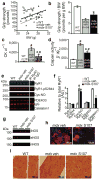Hypernitrosylated ryanodine receptor calcium release channels are leaky in dystrophic muscle
- PMID: 19198614
- PMCID: PMC2910579
- DOI: 10.1038/nm.1916
Hypernitrosylated ryanodine receptor calcium release channels are leaky in dystrophic muscle
Abstract
Duchenne muscular dystrophy is characterized by progressive muscle weakness and early death resulting from dystrophin deficiency. Loss of dystrophin results in disruption of a large dystrophin glycoprotein complex, leading to pathological calcium (Ca2+)-dependent signals that damage muscle cells. We have identified a structural and functional defect in the ryanodine receptor (RyR1), a sarcoplasmic reticulum Ca2+ release channel, in the mdx mouse model of muscular dystrophy that contributes to altered Ca2+ homeostasis in dystrophic muscles. RyR1 isolated from mdx skeletal muscle showed an age-dependent increase in S-nitrosylation coincident with dystrophic changes in the muscle. RyR1 S-nitrosylation depleted the channel complex of FKBP12 (also known as calstabin-1, for calcium channel stabilizing binding protein), resulting in 'leaky' channels. Preventing calstabin-1 depletion from RyR1 with S107, a compound that binds the RyR1 channel and enhances the binding affinity of calstabin-1 to the nitrosylated channel, inhibited sarcoplasmic reticulum Ca2+ leak, reduced biochemical and histological evidence of muscle damage, improved muscle function and increased exercise performance in mdx mice. On the basis of these findings, we propose that sarcoplasmic reticulum Ca2+ leak via RyR1 due to S-nitrosylation of the channel and calstabin-1 depletion contributes to muscle weakness in muscular dystrophy, and that preventing the RyR1-mediated sarcoplasmic reticulum Ca2+ leak may provide a new therapeutic approach.
Figures




Comment in
-
NO may prompt calcium leakage in dystrophic muscle.Nat Med. 2009 Mar;15(3):243-4. doi: 10.1038/nm0309-243. Nat Med. 2009. PMID: 19265820 No abstract available.
-
Fixing the leak.Nat Rev Drug Discov. 2009 Apr;8(4):277. doi: 10.1038/nrd2857. Nat Rev Drug Discov. 2009. PMID: 19348031 No abstract available.
References
-
- Bodensteiner JB, Engel AG. Intracellular calcium accumulation in Duchenne dystrophy and other myopathies: a study of 567,000 muscle fibers in 114 biopsies. Neurology. 1978;28:439–446. - PubMed
-
- Glesby MJ, Rosenmann E, Nylen EG, Wrogemann K. Serum CK, calcium, magnesium, and oxidative phosphorylation in mdx mouse muscular dystrophy. Muscle Nerve. 1988;11:852–856. - PubMed
-
- Blake DJ, Weir A, Newey SE, Davies KE. Function and genetics of dystrophin and dystrophin-related proteins in muscle. Physiol Rev. 2002;82:291–329. - PubMed
-
- Turner PR, Westwood T, Regen CM, Steinhardt RA. Increased protein degradation results from elevated free calcium levels found in muscle from mdx mice. Nature. 1988;335:735–738. - PubMed
-
- Fong PY, Turner PR, Denetclaw WF, Steinhardt RA. Increased activity of calcium leak channels in myotubes of Duchenne human and mdx mouse origin. Science. 1990;250:673–676. - PubMed
Publication types
MeSH terms
Substances
Grants and funding
LinkOut - more resources
Full Text Sources
Other Literature Sources
Molecular Biology Databases
Miscellaneous

